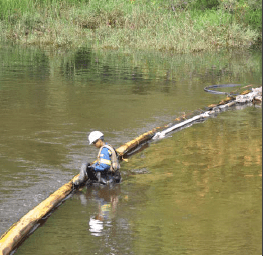APPLICATION INCOMPLETE! In its application to the National Energy Board (NEB) to build Energy East, TransCanada has failed to say how the proposed pipeline would cross three of Canada’s largest and most iconic rivers. Without these critical river crossing details, the NEB panel reviewing Energy East must not begin its review of the proposed pipeline.

In a report released today, Environmental Defence and Équiterre demonstrate that TransCanada’s application to build Energy East is missing fundamental information about the precise location or method of how the proposed pipeline could cross the Saint Lawrence, Ottawa and Assiniboine Rivers. Without this information, it is impossible to assess the potential risks and impacts from oil spills to these iconic rivers and the commercial, ecological, and recreational benefits they provide.
The NEB must not rule TransCanada’s application complete and evaluate the costs and benefits of the proposed pipeline without this vital river crossing information. The clock should not start ticking on the NEB’s Energy East hearing process. And if the NEB were truly interested in learning from the mistakes of the previous review panel and restoring public confidence in the process, it should postpone the Energy East review until after NEB Modernization and the reform of Canada’s environmental laws is complete.
The Energy East pipeline is the largest, longest pipeline ever proposed in North America. It would ship 1.1 million bpd of crude oil 4,600 km across Canada, from Alberta to New Brunswick, crossing nearly 3,000 waterways along the way and putting the drinking water of over 5 million Canadians at risk. If TransCanada cannot even tell us how Energy East would cross three of Canada’s major rivers, how can we possibly trust TransCanada when it says this pipeline is safe?
Our analysis shows how TransCanada’s application has failed to:
- disclose the precise location and method by which Energy East would cross the Ottawa River;
- complete essential feasibility studies for the pipeline’s crossing of the Saint Lawrence River, while also omitting key recommendations in the French version of an essential report about geological risks;
- undertake or make public any study of the impacts of Energy East’s proposed crossing of the Assiniboine River near Portage La Prairie, Manitoba.
Given TransCanada’s track record of pipeline ruptures, there is good reason to expect oil spills that put at risk these rivers and the enormous commercial, ecological, historical and recreational benefits they provide. The Energy East pipeline should not be assessed by the NEB until TransCanada provides this crucial information about the location and method of these river crossings.
Not only is the federal government moving forward with a deeply flawed review process for Energy East by a broken energy regulator, TransCanada has still not provided fundamental information of how its mega-pipeline will cross three of the largest rivers in Canada.
Enough is enough.
Tell the federal government to reject the Energy East pipeline.








